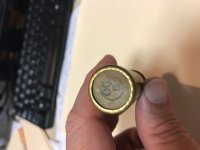Brass shotshell cases have a long history. During the late 19th Century, most hunters loaded their own shotshells in brass cases before they went hunting. Not much in the way of reloading tools was needed beyond a powder dipper and a shot dipper. Factory paper shells became much more popular later. Both brass and paper shells were used by the military during WWII. Most shotgun combat use was during the Pacific campaign, and brass shells were used there. I don't remember ever hearing about shotgun use, at least under combat conditions, in the ETO, or later, in the Korean War. The moist and wet conditions in the Pacific affected paper cases adversely. Remington once made a waterproof paper shotshell mainly for duck hunters, under the "Arrow" brand. The paper case was coated with clear shellac, and they are easily distinguished by their glossy appearance. I have one specimen of a 00 Buck 12 gauge Remington "Arrow" shell, but have no idea whether it might have been military. Plastic shotshell cases made their first market appearance in the early 1960s and provided satisfactory moisture resistance for combat use, and were well established by the Vietnam War era. There may have been some brass case shotshells left over from WWII used in Vietnam, but I am not sure of that.



